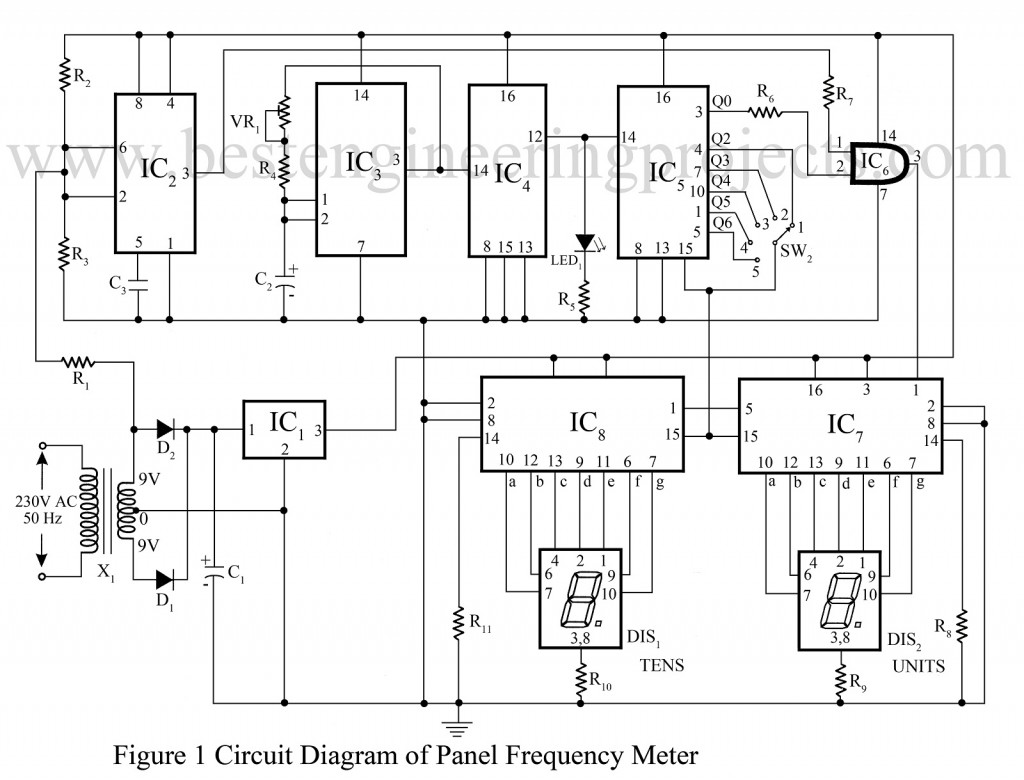Generally, the standard line frequency in some countries is 50HZ or in some countries 60HZ, which may vary from time to time. Due to this varying nature of frequency, sensitive equipment may start malfunctioning, and the requirement result we may not get. New here is a simple mains line frequency meter circuit designed and verified at BEP (Best engineering project) lab used to measure the frequency of AC mains.
Circuit description mains line frequency meter circuit
The circuit of the mains line frequency meter is built around timer IC2 (NE555), oscillator-cum-driver IC (IC3), decode counter, AND gate IC (IC6), seven-segment display and 6-volt regulator IC. The AC mains input (230v) is stepped down using a 9v-0-9v step-down transformer. The output from secondary winding is rectified by full-wave rectifier using diode D1 and D2 which are further filtered by capacitor C1 and given to the input of voltage regulator IC (IC1) to produced regulated 6v DC.
The stepped down 9v is connected to pins 2 and 6 of IC2 (timer IC) for converting the sine wave into square wave frequency.
This converting is done because the square wave is more suitable for the circuit operation than sine wave.
The 10HZ clock pulse is generated by IC3 which is wired as oscillator-cum-divider. The outputs 10HZ clock pulse are given to the clock pin 14 of decode counter IC5 (4017).IC5 divides the 10HZ clock by 10 to obtain a 1 Hz clock pulse. The output of IC3 from pin 3 is again fed into its input pin through VR1 and R4. Capacitor C2 is used as a charge/discharge capacitor and is connected between the input of IC3 and the ground. The value of output frequency from IC3 is dependent upon VR1, R4, and capacitor c2, the value of this component is so selected that its output is accurate 10 Hz clock pulse.
LED1 is connected to the output pin of IC4 gives one flash per second to indicate the 1HZ clock pulse. The 1HZ clock pulse is connected to another decode counter clock pin 14 of IC5. The output from pin 3 is given to pin 2 through resistor R7 and square wave output from IC2 is given to pin 1 to IC6. Therefore, the unknown frequency of the AC mains line, applied to pin 1 of AND gate (IC6) passes through it for only one second and is connected by IC7 and IC8.
IC7 and IC8 are configured to drive 7-segment display DIS 1 and DIS2 respectively to display the frequency. DIS1 is used to display the unit place of frequency and DIS2 is used for tens place.
This circuit is so designed that it is an auto-reset circuit, but you can select the reset time of 1 second to 5 seconds using rotary switch SW2, which is connected to the reset pin of IC2, IC7, and IC8. For long-time display of the frequency, keep the knob of rotary switch SW2 towards the fifth position. For instant see any variation in the supply frequency keep the knob of rotary SW2 towards the fifth position. For instant see any variation in the supply frequency keep the knob of switch SW2 to position 1.
PARTS LIST OF MAINS LINE FREQUENCY METER CIRCUIT
|
Resistor (all ¼-watt, ± 5% Carbon) |
|
R1, R5, R6, R7 = 1 KΩ R2, R3 = 1 MΩ R4 = 10 KΩ R8, R11 = 100 KΩ R9, R10 = 470 Ω VR1 = 47 KΩ |
|
Capacitors |
|
C1 = 1000 µF, 25V (Electrolytic Capacitor) C2 = 47 µF, 16V (Electrolytic Capacitor) C3 = 0.01 µF (Ceramic Disc) |
|
Semiconductors |
|
IC1 = LM7806 (+6V Series Voltage Regulator) IC2 = NE555 (Timer IC) IC3 = CD4093 (Quad two input NAND Schmitt-trigger IC) IC4, IC5 = CD4017 (CMOS Decade Counter IC) IC6 = 7408 (Hex inverter buffers IC) IC7, IC8 = CD4033 (Johnson counter IC) D1, D2 = 1N4007 (Rectifier Diode) DIS1, DIS2 = LT543 (7-segment Display) |
|
Miscellaneous |
|
SW1 = Rotary Switch X1 = 230V AC primary to 9V-0-9V 250mA secondary transformer LED1 |
